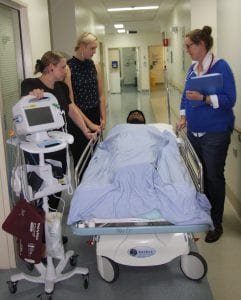Code Stroke
A new emergency medical response code is allowing patients who suffer from a stroke while in hospital to be treated quicker and prevent life affecting complications.
Code Stroke, an initiative of The Prince Charles Hospital’s (TPCH) Acute Stroke Service, was introduced to activate a targeted hospital-wide emergency response to support patients who suffer a stroke during a hospital admission.
Senior Stroke consultant, Dr Kathryn Colebourne said that a stroke is a very specific medical event that requires the attention and expertise of a specialised team of staff.

A Code Stroke response requires the attention and expertise of a specialised team of staff.
“When a patient suffers a stroke, there is only a short window of time to identify and respond medically before their condition deteriorates substantially,” Dr Colebourne said.
“If a stroke is not managed in a timely and appropriate way, this can mean the difference between a patient walking out of hospital or never walking again.
“Rapid and targeted assessment and care for these patients is critical.”
Unlike a normal emergency medical response code, Code Stroke activates a 24/7 stroke-centred response involving senior members of the hospital’s Acute Stroke team, general medicine, radiology and pharmacy.
“These services play a vital role in the immediate diagnosis and treatment of stroke as well as in facilitating the appropriate follow up care for patients,” Dr Colebourne said.
Since its introduction in 2018, the Code Stroke process has resulted in greater identification of the acute stroke patient who has suffered their stroke while already being treated in hospital for an alternative condition.
TPCH records demonstrate that during 2014-15, prior to the introduction of Code Stroke, inpatient strokes accounted for only 3 per cent of TPCH’s total stroke patient admissions. This compares with 2019 records which show that inpatient stroke accounted for 25.5% of the hospital’s total stroke admissions.
The Code Stroke process is particularly relevant for a hospital like TPCH which has a large cohort of cardiothoracic and complex cardiology patients where stroke is more prevalent due to the complexity of treatment administered to this very challenging patient cohort.
The success of the new code process in responding to increasing numbers of patients who suffer a stroke in hospital, can be attributed to the comprehensive hospital-wide education program led by Acute Stroke service Clinical Nurse, Caitlin Kearney.
“Stroke does not discriminate – it can occur in patients of all ages and with different clinical issues,” Caitlin said.
“It is essential that all clinical staff, no matter what their speciality, understand the complexities of stroke and know how to recognise the signs and symptoms.
“A stroke can present in many different ways ranging from overt motor weakness, speech deficits, or gait difficulties. It has the potential to remain unidentified if clinicians are not educated correctly.
“Our education program has ensured that staff across the organisation are empowered to know what to look for, and can effectively activate a Code Stroke if needed, so that help arrives in a timely way for the distressed patient.
“This education can ultimately save a patient’s life and improve and maintain their quality of life moving forward.”
QUALITY OF CARE
TABLE OF CONTENTS
